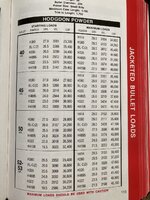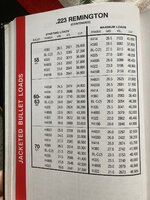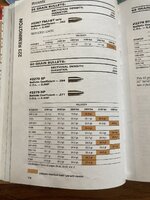Gold Supporter
- Messages
- 24,463
- Reactions
- 37,077
Follow along with the video below to see how to install our site as a web app on your home screen.
Note: This feature may not be available in some browsers.


Thank you for the load data. My Hornady 9th edition only shows one H-380 load and it's for 50gr bullet. What edition is your book?View attachment 1098362
I recall loading some .223 with H-380 years ago. If I recall, I used Winchester 55 gr SP bullets with Hodgdon's max load. The velocity was unimpressive, accuracy was okay. This was pre AR for me, so can't tell you if it would run in an AR. Definitely would use heavier bullets if I were to try it today. View attachment 1098363
Hodgdon Data Manual No. 25 March 1988.Thank you for the load data. My Hornady 9th edition only shows one H-380 load and it's for 50gr bullet. What edition is your book?
Possibly, but current Hodgdon data for the 22-250 actually shows heavier loads than my 1988 manual, implying that the current version might be slightly slower burning (or that they have more accurate pressure measuring systems now.)Need to confirm that Hodgdon has not changed the makeup of the powder which affects burn rate.
Might be the reason why it's no longer shown for certain loads.


I totally agree. I'm going to guess that H380 is better for 22-250 because the case capacity is so much greater. I did like it in my 22-250. I don't see why it wouldn't be okay in .223, it might not be the "Best choice". But any port in a storm within safety parameters right?Possibly, but current Hodgdon data for the 22-250 actually shows heavier loads than my 1988 manual, implying that the current version might be slightly slower burning (or that they have more accurate pressure measuring systems now.)
Here is data for the .223 Remington from Hornady Handbook 4th Addition for H-380 with their 50 and 60 gr bullets from 1991.
View attachment 1098470View attachment 1098471
I think the main reason current data excludes H-380 for .223 is that there are so many better powders available for the cartridge (or would be, if they indeed were available). I am quite confident you can load H-380 in .223 cases safely. You just won't be achieving full potential, velocity wise. Would suggest using magnum primers to avoid potential hang fires, especially in cold weather.
This might explain why it's not listed for some cartridges any longer.I stopped using H380 a couple of decades ago, it was "twitchy". A couple of tenths of a grain in the wrong direction and you were blowing primers (even at well below max load data).
Lots better powder choices out there for 223 than H380.
This is the kind of thing that drives me crazy and causes me to stick to the paths more commonly trodden.I stopped using H380 a couple of decades ago, it was "twitchy". A couple of tenths of a grain in the wrong direction and you were blowing primers (even at well below max load data).
Maybe in a 22-250 or .243 Win., but I seriously doubt you could stuff enough H-380 in a .223 case to flatten a primer, much less blow one.I stopped using H380 a couple of decades ago, it was "twitchy". A couple of tenths of a grain in the wrong direction and you were blowing primers (even at well below max load data).
Absolutely agree. I can easily name a dozen powders off the top of my head that would perform better than H-380, but if H-380 is all you have and you don't mind having your velocity limited, you can use it. Even at full capacity, pressures generated are mild. Under charging may possibly lead to detonation, so stay within published ranges as shown in manuals I (and others) have referenced.Lots better powder choices out there for 223 than H380.